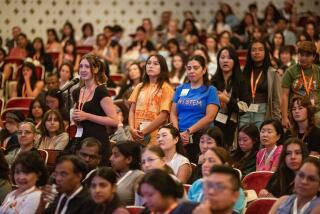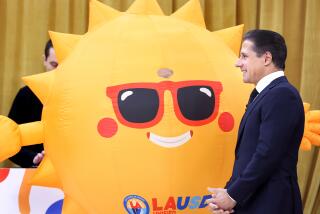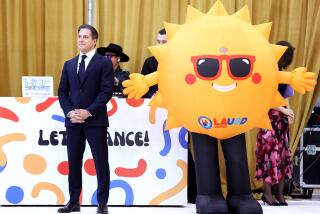He makes physics fun
GOLETA, CALIF. — It was lunch hour and hundreds of Dos Pueblos High School students surged onto the bleachers at the school’s outdoor Greek Theater. The crowd was cheering, the music was thumping and a student-built robot named Penguinbot IV was wheeling and pivoting, sucking up dozens of lightweight balls and shooting them at the young athletes who had ventured onstage.
From a console to one side, teenagers in black, NASA-style jumpsuits guided the 150-pound machine as it weaved and dodged. When the robot and star basketball player Jay Larinan began pelting each other, a girl in the stands screamed, “I believe in you, Jay!” The crowd went wild.
It was the kind of free-spirited scene that gladdens the heart of Amir Abo-Shaeer, the 39-year-old physics teacher who each year leads the school’s robotics team into a rigorous national competition that requires months of preparation and a season’s worth of intense face-offs.
“There are plenty of robotics teams that are holed up in closets and have never seen the sun before,” he said. “But these kids are walking around totally proud, wearing their flight suits and their patches. They’re building crazy, awesome stuff, and we’re bringing busloads of fans to their competitions. There’s no doubt that it’s cool.”
Or who made it that way.
At a time when the profession is under attack, Abo-Shaeer has emerged as a national example of great teaching.
Last year, he was awarded a MacArthur Foundation $500,000 “genius” grant, the first high school teacher to win one. He and his robotics team -- known as Team 1717 and the D’Penguineers -- are the subjects of a recently released book, “The New Cool.” A film is in the works.
And while Abo-Shaeer likens navigating the educational system to wading through peanut butter, he has managed to launch an in-school engineering academy and to raise $6 million for it.
Not bad for a hometown guy who could have made a lot more and worked a lot less if he hadn’t decided to become a teacher at his old public high school.
Abo-Shaeer grew up in Goleta, the son of an Iraqi theoretical physicist who had worked and studied on four continents.
As a young man, Muhsin Abo-Shaeer had so excelled at math and science that the Iraqi government prepared him for a science career the way Russia grooms gymnasts for the Olympics. But when he settled in Santa Barbara, where he’d earned his doctorate, and couldn’t find a physics job, he started mowing lawns for a living.
“When I grew up, I knew people looked down on what he was doing,” Amir Abo-Shaeer said, “but he actually loved it. It gave him time to write poetry, to become the Renaissance man he wanted to be without the baggage of having to have people see him as successful.”
It was a lesson his son took to heart.
As a Dos Pueblos student, he got good grades but cared most about playing drums for band director Ike Jenkins.
When Abo-Shaeer talks about Jenkins, he sounds much like his own students describing him: “He was so willing to talk and be open and be himself. He treated students as if it were a partnership.”
After high school, Abo-Shaeer worked his way through UC Santa Barbara bagging groceries. He found it more fulfilling, he says, than his main job following grad school. The Goleta-based company he worked for made racks for industrial telephone equipment and Abo-Shaeer designed rack variations. He was bored out of his skull -- stuck for six years in a position whose perks included insomnia and back pain.
One of his few sunny moments was using a teacup and spoon to teach a colleague thermodynamics.
“He totally understood it,” Abo-Shaeer recalls. “You could see a major light bulb going on.”
Abo-Shaeer had liked being a teaching assistant at UC Santa Barbara and began taking education classes there. In 2001, when a job opened at Dos Pueblos, he jumped. “I didn’t realize how much I would love it,” he said.
--
When he feels like it, Abo-Shaeer comes to work wearing shorts, a T-shirt, and a day’s stubble. Students vie to get into his classes, where they find a man both laid-back and relentless.
In Advanced Placement physics, he rails against standardized tests, but urges his students to ace them. “It’s like me and them against The Man,” he says. Only one or two of the 60 AP students he teaches each year flunk the test.
The AP test epitomizes the kind of education he detests: swamping students with information they’ll soon forget instead of helping them absorb a few important topics in depth.
Reviewing a practice test one recent morning, he warmed up the room like a standup comic before moving on to gravity vectors and force fields. When a student in the front row nodded off, he crouched in front of him, leaned into his ear and, in a hoarse stage whisper, asked: “How ya doin’?”
“He’s like, ‘Just shoot me!’” Abo-Shaeer told the class. “He’s like, ‘I’d rather be anywhere than here!’”
The same morning, in his robotics class, he slipped into another role: chief executive of a high-tech startup.
Sitting on a desk in his cluttered classroom, he issued a rapid-fire to-do list. New air tanks would be arriving and someone had to rig them up. The team would be doing a presentation for 300 Pasadena middle school kids and someone needed to shoot new video of this year’s robot, Penguinbot VI. As for Penguinbot VI’s off-kilter locomotion, did anyone have any brilliant ideas?
Little missteps -- not major flaws -- had cost the team a victory at the Long Beach regionals, he said. He urged everyone to take a deep breath.
“It’s a bad idea to focus now on perfection,” he said. “Is there anyone here who thinks we lost because our robot wasn’t ready?”
Not a hand went up.
A boy typing away at a computer announced he’d found a good deal on pneumatic tubing. A girl took down names of vegetarians for an upcoming lunch. Then talk turned to the book signing the next day: Someone would have to return calls from people eager to get their kids into the engineering academy.
“Some of you will have to talk the parents off the ledge,” Abo-Shaeer said.
--
Not long after he was hired at Dos Pueblos, Abo-Shaeer was asked to launch a four-year engineering program.
Soon he was drawing students from all over the district -- including girls, who often don’t feel welcome in such programs. What he calls his “sage-on-a-stage” routine played well in a town dominated by a university and the high-tech companies that have grown around it.
Before long, the academy was squeezed for space -- especially its 32 seniors, who each year form the robotics team and need a lot of room to work.
In the summer of 2007, Abo-Shaeer heard about a $3 million state grant for technical education not much more than a month before the deadline. Other districts had hired consultants to put together bids. He enlisted his wife, Emily, who was commuting to UC Irvine for a graduate degree, and drafted a 50-page proposal. It won.
Then he had to raise $3 million in required matching funds.
“I got people believing we could actually do this,” he said.
Parents started fundraising. Abo-Shaeer, his students and their robot appeared before CEOs and service clubs. Virgil Elings, a nanotechnology pioneer, gave $1 million. Companies big and small chipped in.
The academy’s new building will open next fall, allowing enrollment to triple.
Senior Dalia Khammash has had to pull a string of all-nighters this year. That’s what happens at crunch time, when a million robot details have to be worked out and the team ends up practically living at Dos Pueblos.
“One morning my mom came in and found me under a table,” said Dalia, who wants to be a neurosurgeon. “She said, ‘What are you doing?’ And I said, ‘Sleeping.’ ”
This year’s robot is required to pluck plastic triangles, squares and circles off the floor, locomote to a wall, and place the shapes on pegs in specific patterns. It also has to carry a mini-robot capable of climbing a 10-foot pole in seconds.
Like her teammates, Dalia has strayed well outside her comfort zone. She machined some of the robot’s nearly 2,000 parts on precision equipment, although she had never before touched a mill or a lathe.
--
That’s just the sort of thing inventor Dean Kamen was hoping for in 1992 when he launched the robotics tournament called FIRST -- For Inspiration and Recognition of Science and Technology -- out of fear that pop culture was turning young American brains to mush.
FIRST’s student teams design, program and build robots, with new specifications each year. Some 2,200 teams start out, all hoping to get to a national bout attended by tens of thousands of avid fans.
“It’s a copy of every other high school sport, with a short, intense season, double-elimination tournaments, cheerleaders, bands, everything,” Kamen, who is best known for the Segway, explained.
FIRST was a natural fit for Abo-Shaeer.
“It’s not like I’m throwing them out in the jungle with sticks and telling them to go make fire,” he said. “But it’s good for students to experience inexperience. Inexperience is the experience.”
The team is competing in the championship this week in St. Louis.
As for Abo-Shaeer, his biggest new experience is fame, though it doesn’t seem to faze him much. He has no particular plans for his MacArthur windfall. He hasn’t paid off his tract home, and he’s still driving a 20-year-old pickup. “If I wanted to not teach for a year and go investigate something,” he said, “I could do it.”
But for now, there’s teaching to do.
In AP physics recently, he likened a diagram of subatomic particles to trees on a hillside. “That’s like real life,” a student said, and Abo-Shaeer beamed.
“Yes!” he said. “Real life! Bringing it to the people!”
--



